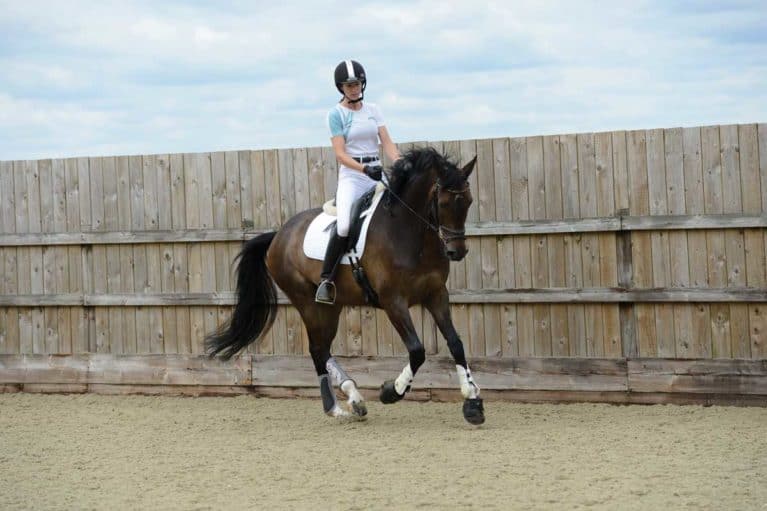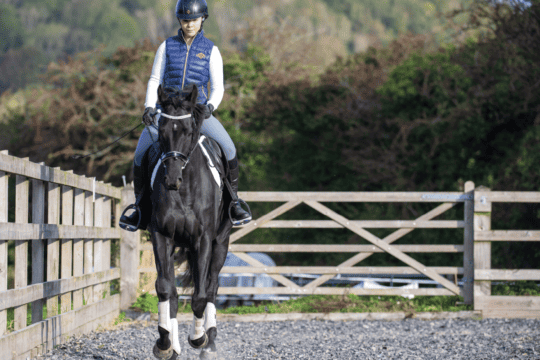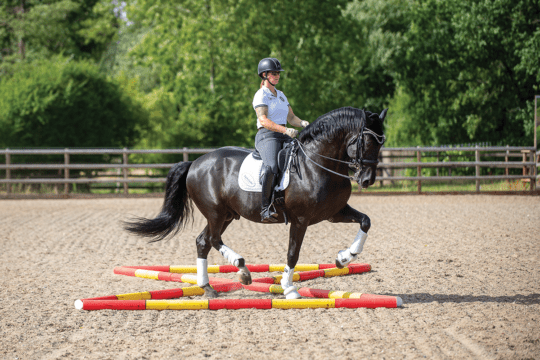Featured Professional

Sandy Phillips
Sandy is an FEI judge for eventing and dressage, and trains horses and riders of all levels.
Scores not up to scratch? Dressage coach and FEI judge Sandy Phillips shares her competition pet peeves and explains how to get back on track

Dressage is a complicated sport with many layers that impact on each other. The quality and success of an entire movement can be undone by one minor error in execution. In addition to this, horses and riders each have their own strengths and weaknesses, which is why it’s misleading to make sweeping statements about the right or wrong way to do things. However, there are exceptions to every rule and there are a few common errors that come up in many tests that consistently rob riders of points. Here are a few of the common mistakes I see when I’m judging and what you can do to avoid or fix them.
1. Sitting incorrectly
Identifying the problem: The way you sit directly affects the way your horse moves beneath you. If you’re perched on the front of your pelvis, your horse will fall onto his forehand and out through his shoulder. If you sit too far back, which is a common problem in dressage riders, you’ll be inadvertently driving your horse, causing him to hollow. The temptation is always to try to correct these errors by using too much leg, which causes your horse to switch off to your aids and, in turn, forces you to increase the force of the aid each time. If someone were to nudge you consistently, you’d learn to ignore it after a while, then it would take a punch to get your attention, and you wouldn’t like that any more than your horse does. You’ll be able to dial back your leg aids if you correct your centre of gravity and learn to sit in the middle of your horse.
How to fix it: In walk, practise feeling the mechanics of the gait. Can you feel when the left hind leaves the ground? How about the right? If you’re sitting incorrectly, or are tight or gripping with your seat, you won’t be able to feel it. Only when you’re sitting centrally and with your hips relaxed will you be able to differentiate between the motions, then it’s easy, and you can start identifying how much ground cover your horse is making with each step. Is he overtracking by 30cm? Or is it just 15cm? Is he just tracking up into the print left by his front hoof? Once you can finesse your feel enough to know where each step will finish, you can start to influence his stride length. Experiment with using your seat, not your reins, to shorten the stride by 10cm. This should be accomplished by encouraging your horse to lift his stride – practise over poles and cavaletti to get the feeling.
Top tip – It helps to have someone on the ground to observe and let you know if what you’re feeling is what’s actually happening.
2. Overriding with the hand
Identifying the problem: A lack of understanding of the mechanics behind a good outline causes many people to ride with too much hand, which causes their horse to lean. I also see many riders use the reins to balance themselves instead of developing their own balance in the saddle. Your horse can’t carry himself or work correctly if he’s using your hand as a fifth leg. A stiff, restrictive hand, or a variable or see-sawing contact are incorrect and encourage leaning or evasion of the contact.
How to fix it: Firstly, ensure you have your own balance in check, otherwise your horse will never be able to develop his own. When he leans on you, use the swing of the movement from your horse’s quarters to allow him to push ahead of you so that you can soften your contact. When he has sufficient energy and impulsion, he’ll come up and naturally balance himself, but if there’s not enough activity from his hindleg, then his front end will drop and look for the contact to balance on. Use one or two steps of leg-yield to encourage more activity and be strict with yourself about maintaining a light contact. Ask for transitions in the corners and allow your horse to go forward into a steady contact. Don’t be tempted to cheat your way to an outline, but rather allow your horse to work from back to front, then into your hand.
3. Driving the free walk
Identifying the problem: The free walk is a deceptively difficult part of a dressage test. If you drive too much with your seat or legs, your horse will lift his head and hollow in response, which will cause you to react by using your hand to lower his head. Then he’ll fall onto his forehand, effectively precluding any chance of a good score for the movement.
Horses are naturally built on the forehand, so your aim is to encourage engagement, which will help lighten his front end and shoulders, and gradually encourage him to take more weight behind. Riding a good free walk is about your horse taking balanced steps, developing suppleness in his back and encouraging maximum ground cover. It’s a mainstay in dressage tests up to Medium level, and it’s often worth a double coefficient score, because it’s a test of how correctly your horse is working and how correctly you’re riding. If you’ve taken any shortcuts or are relying on your hands, it’ll all come out in the wash during your free walk.
How to fix it: Engagement and balance have to be in place before you transition from medium to free walk. Driving into the transition, or after it, may get it over and done with quicker, but it won’t do your scores any favours. If you’ve been practising identifying and adjusting the length of your horse’s walk stride at home, you should be able to shorten and balance him in the corner before the transition by containing the motion of your hips and, therefore, his energy. Allow a more open, following motion through your hips as you lengthen your reins, which will allow your horse to open his stride and his frame, and march in the free walk. If he’s working correctly, you’ll be able to gather him back up at the end of the movement without him hollowing or falling out through his shoulder.
Top tip – A good free walk requires a long – but not loose – rein. Don’t throw the contact away entirely, but rather ask your horse to stretch down and seek it.
3. Cutting off corners
Identifying the problem: Corners don’t have to be complicated, but a lot of riders make them so by not being brave enough to ride right into them. They turn too early, which means they lose marks for accuracy, and also means that they don’t reap the benefits of having the corner to rebalance and prepare for the next movement. If you keep riding into the corner, your horse will have to take responsibility and turn eventually – after all, there’s a visible barrier to stop him. He has to learn to make that decision himself and if you pull him out of every corner prematurely, he never will.
How to fix it: You don’t have to ride into the corner thinking ‘inside leg, outside rein’, keep it simple. Use the corner to let your horse find his own balance. Ride in straight, let your horse turn, then ride out straight. It’s as easy as that. This will establish the balance needed to carry on down the long side, transition or cross the diagonal – whatever you need to do, your horse will be ready for it.
4. Losing your temper
Identifying the problem: This is a particular bug-bear for me. I remember judging a rider who was battling with her horse because she rode with such a strong hand that she couldn’t get a canter-walk transition. I gave her the benefit of the doubt and thought ‘perhaps she’s having a bad day or perhaps it’s a difficult horse’. Then she came in on a second horse, gave him a jerk in the mouth and that was that. I gave her a very bad mark for her riding and told her that she needed to control her temper in the test. If she needs to ride like that, then she needs to stay at home and practice until she can present a more pleasing picture. I’m not prepared to promote that sort of riding.
How to fix it: It’s important to train a level above the one you’re competing at. I see so many riders doing a test where they can’t ride a movement correctly, but your horse should be confirmed at home in all the movements in a test before asking him to perform them in a competition situation, so he has confidence in the work and isn’t stressed. Keep it simple and at a level you’re both confident with, and don’t put yourselves under unnecessary pressure. Riding is supposed to be fun and you’re supposed to enjoy what you’re doing. If you can’t manage the perfect test on the day or you and your horse aren’t performing to the standard you usually do, then just take what you can manage that day and put a smile on it.















